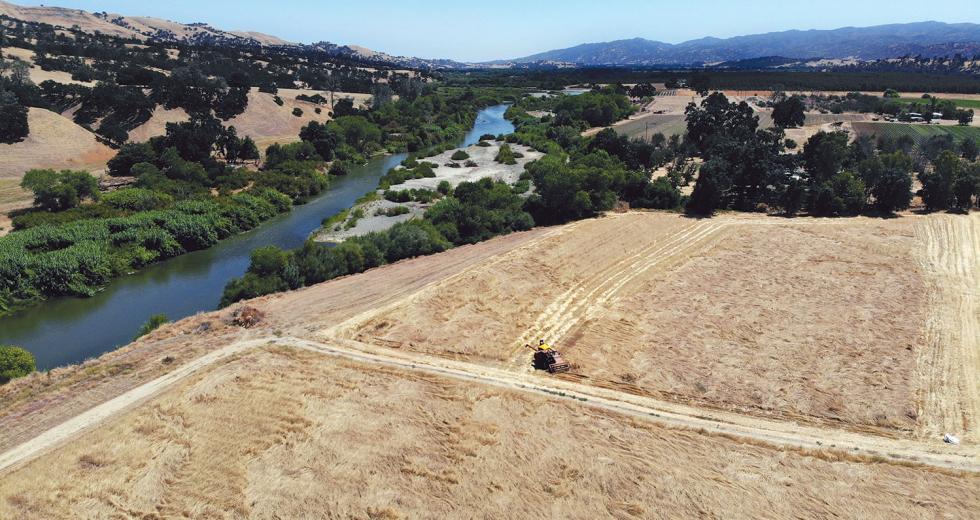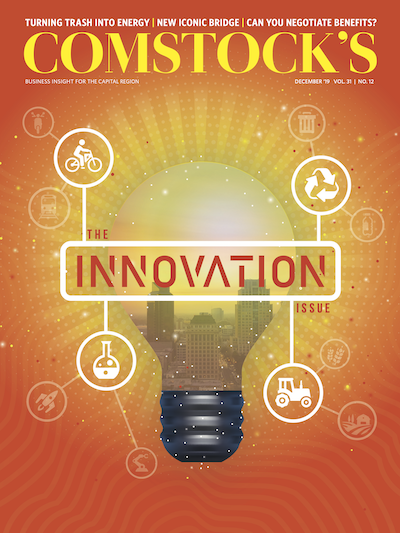David Kaisel has to run to the hardware store. He needs to fix his combine harvester, he explains, taking off his ball cap to run a chapped hand through his brown hair, as he stands on the sidewalk outside the mill he runs from a small storefront in Esparto. Then he’ll drive the 65-year-old piece of equipment ever so slowly down Highway 16, clunking along to the field he’s leasing in Guinda, where he’ll spend an August afternoon in 100-degree heat harvesting heirloom wheat.
Once at the field, Kaisel takes stock of the work ahead. He leases about 12 acres on four fields from Riverdog Farm, a 450-acre certified organic farm that grows vegetables, fruits and nuts, and raises livestock; the heirloom wheat is part of Riverdog’s crop rotation system to improve soil health by preventing erosion and deterring pests, among other benefits.
Kaisel is harvesting late this season. Sales for his business, Capay Mills, were “quite a bit higher” than last year, increasing 41 percent, so he’s been busy milling flour and has less time for other tasks. Plus, record-breaking rain over the winter made it impossible for him to plant all of his acres (he leases 18 total, including 6 acres on three fields from other landowners). He suffered another setback in June when the Sand Fire scorched 2,500 acres in Yolo County, and he lost 2 acres of grain. He says he also lost a small amount of grain in a field by a fire station, where a helicopter landed to transport an injured firefighter. This fire season is expected to again bring above-normal activity in California, though not as extreme as 2018, which saw more than 7,500 fires and more than 1.6 million acres burned and included the deadliest and most destructive fire in state history. Kaisel lost about $15,000 worth of farm equipment — tractor, mower, forklift and other tools — when flames tore through his property in Rumsey. His house just barely survived.
“The downside of heirloom grass, this is what’s called lodge,” Kaisel says, referring to how the tall stems are bent over. “This should all be yea high.” Kaisel raises a hand up to his chest. “But this got all knocked down by the late rains in May.” This foisy, a white wheat developed in Oregon in 1865, is “the best I’ve ever seen,” he says, “so it’s worth going for.”
David Kaisel, owner of Capay Mills, harvests a field of foisy and
white Sonora wheat in Guinda.

Kaisel is trying to bring back a relic from America’s past: local grains, when flour was a fresh, nutritious food, and every community had its own mill. He sees heritage grains as an untapped market of today’s farm-to-fork movement. But his work is part of something bigger: He considers himself an “advocate for cereal grains as a cornerstone of sustainable and regenerative agriculture, especially climate-resilient farming.” A growing movement of farmers is focused on agricultural practices that can mitigate or adapt to an uncertain future brought by climate change, predicted to include more heat waves, more droughts, more flooding, increased frequency and intensity of wildfires, less snowmelt, fewer chill hours, and new pests and diseases.
Yet, as a chorus grows around the need for climate-resilient strategies and as efforts are underway to innovate solutions, farmers in the Capital Region facing these challenges are calling on other stakeholders to do their part too. The battle, they say, is not theirs alone.
Rethinking the Food System
A California native, Kaisel, 60, worked on a farm in England for three years when he was in his 20s, tending to sheep. In his 30s, he visited Capay Valley for the first time, traveling from the Bay Area to learn to paddle white water on Cache Creek, a sport he picked up while living in Italy. “It was just so beautiful,” he says. “These groves of almond trees in blossom and the hills on either side. And that time of year when you paddle, January and February, everything is so green, and I just thought it was spectacular.” He imagined that this valley dotted with small farms and towns resembled California a century ago.
In the early 2000s, Kaisel worked as a product designer in global development and public health, and one of his projects involved subsistence farmers in Kenya. “I saw what they were capable of producing with (limited) resources, and I just found it very appealing, and it made me think more about what we’re doing in the U.S.,” he says. Kenyans had local food systems and diversified farms that integrated a variety of crops, grazing animals and pastures, creating an agroecosystem with multiple benefits, such as reducing the need for chemical fertilizers; providing flood control; encouraging beneficial insects, birds and mammals to prey on pests; and promoting a closed-loop system that recycles nutrients and organic matter back into the soil.
Here in the United States, Kaisel saw a large-scale, industrial, monoculture model — farms produced single crops — that had “completely divorced farmers from the community that they’re part of.”
The experience eventually led Kaisel to participate in the California Farm Academy in Winters. After graduating in 2014, he returned to Capay Valley to launch Capay Mills, growing grains to mill into artisanal flour. His customers include bakers and chefs in Sacramento and from esteemed restaurants in San Francisco and Los Angeles, as well as foodies across the country. The latter group he equates to devotees of craft brew who geek out on minutiae; in his case, indicators of grain and flour quality like stability time (how long the dough maintains its strength) and absorption (how much water the flour can absorb), Kaisel says. “You need to be obsessive to do this work, and I’m lucky that my customers are even more obsessive than I am,” he says.
Wheat originated in the Fertile Crescent of the Middle East, and its domestication went hand in hand with the rise of civilization. Having come from the desert, wheat likes heat and does fine without irrigation. “There’s a reason why it was 60 percent of our calories for 10,000 years,” Kaisel says.
About 50 years ago, modern wheat came out of the Green Revolution when selective breeding for high-yielding varieties of wheat and rice led to a massive increase in production, helping to feed the developing world. But it was not without a cost: Large amounts of chemical fertilizers and pesticides are needed, because modern wheat is short and competes with weeds, which means conventional growers need to spray a glyphosate-based herbicide like Roundup. Ancient wheat — like what Kaisel grows — is tall; weeds growing underneath don’t interfere. Additionally, for poor farmers who can’t afford chemicals, these modern varieties may produce lower yields than older varieties better suited to local climates and conditions.
David Kaisel uses a stone mil inside a small storefront in
Esparto. He plans to move to a larger facility in the next few
years.
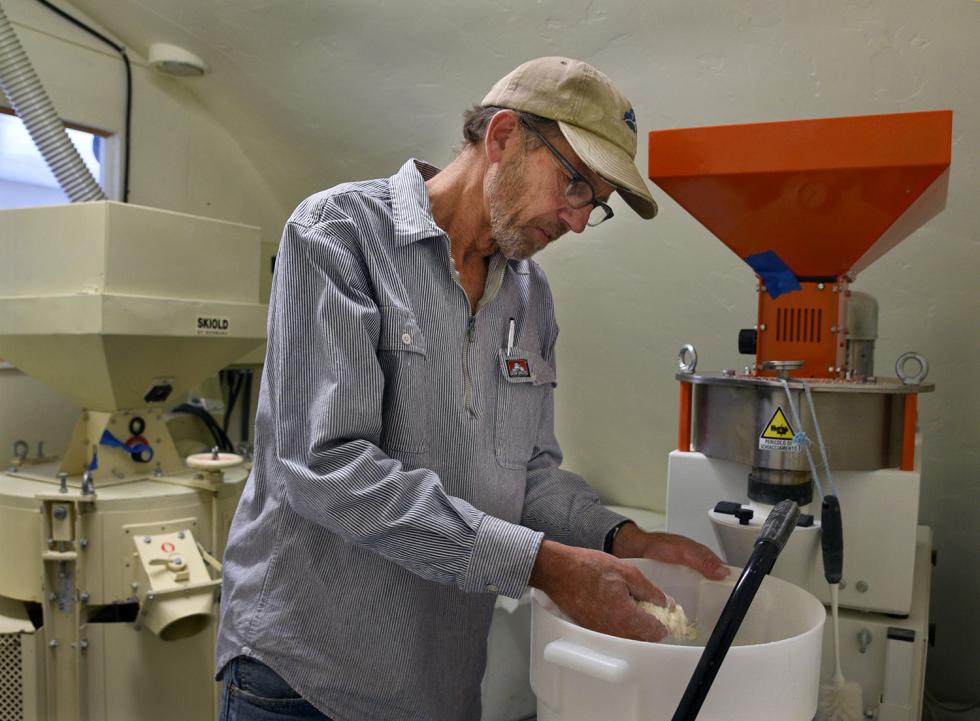
Out in the field in Guinda on this hot August day, Kaisel finds some white Sonora wheat mixed in with the foisy. Europeans introduced white Sonora to North America about 300 years ago. It is adapted to arid environments and can be dry-farmed or rely on collected rainwater. “You can plant this stuff in a parking lot, and something will come up,” he says, adding that it has the ability to keep people from starving.
“I’m screwed in terms of selling the seed, which is kinda too bad, because that is where the value is for me,” he says, running some grain through his palm, seeing how the Sonora and foisy have intermixed. “But for baking, I think this is going to be incredible. This is what farmers used to do, and they still do in England. They intentionally mix everything up, and they’ll plant 50 varieties. … You don’t know what the weather is going to be this year, so you plant everything, and something’s going to come up, and then you end up with these really interesting combinations. So your bread is going to taste different from year to year. What’s wrong with that?”
Making Soil Healthier and Alive
In mid-August, I drive through the curving roads of rural Placer County near Auburn to Hillview Farms, a 10-acre property with 2 acres in production farmed by Shanon and Michael Whamond, who grow tomatoes, lettuce, arugula, peppers, broccoli, melons, cucumbers, carrots, radishes, eggplant, onions, squash, zucchini and more. The certified-organic Hillview uses cover crops, compost and low tillage to promote soil health and prevent carbon from being released into the atmosphere.
They see soil as the be-all and end-all to their operation and treat it as such. In doing so, they’re both mitigating climate change by reducing the carbon output of their operations, and they’re attempting to adapt based on their strong belief that healthy soil will grow better plants and position them to better withstand extreme weather events.
“This is a hard time of year because we’re trying to keep the fall plantings alive because it’s so hot, while trying to extend summer production as long as we can through the heat,” Michael Whamond says. “For us, this is like the craziest time. It’s just go, go, go, go, and then, hopefully, in the winter time we take a little breather.”
Hillview is one of five small-scale diversified vegetable farms participating in a pilot project of the Community Alliance with Family Farmers. The Davis-based nonprofit organization is undertaking four projects as part of its Climate Smart Farming program, launched in 2017. The project at Hillview will evaluate the effectiveness of occultation, which involves watering a plot to bring up the weeds, then laying a tarp down over the plot for a period of time and seeing how the weeds respond. They’re also studying produce yields and quality, and labor hours.
“One of the challenges of not tilling intensely is weed control, especially for organic farms,” says Emily Buerer, program coordinator for CAFF’s Climate Smart Farming program. “They don’t have access to really heavy-duty herbicides, so you have to basically innovate and figure out, well, how are we going to control our weeds?” Buerer is at the farm on this August day with colleague Kali Feiereisel to collect samples from two rows of carrots.
Michael Whamond says they need to get rid of the worst weeds — Johnsongrass, Bermuda grass, vine weed, the stuff that “makes organic farming almost unbearable.” Organic farmers want “living soil,” with organic matter and millions of microorganisms. Organic matter is decomposing plant or animal material that provides nutrients for the soil and improves its water-holding capacity by strongly binding soil particles together. More diverse microorganisms mean more nutrient-dense fruits and vegetables.
Some foisy and white Sonora wheat have intermixed in a field in
Guinda.
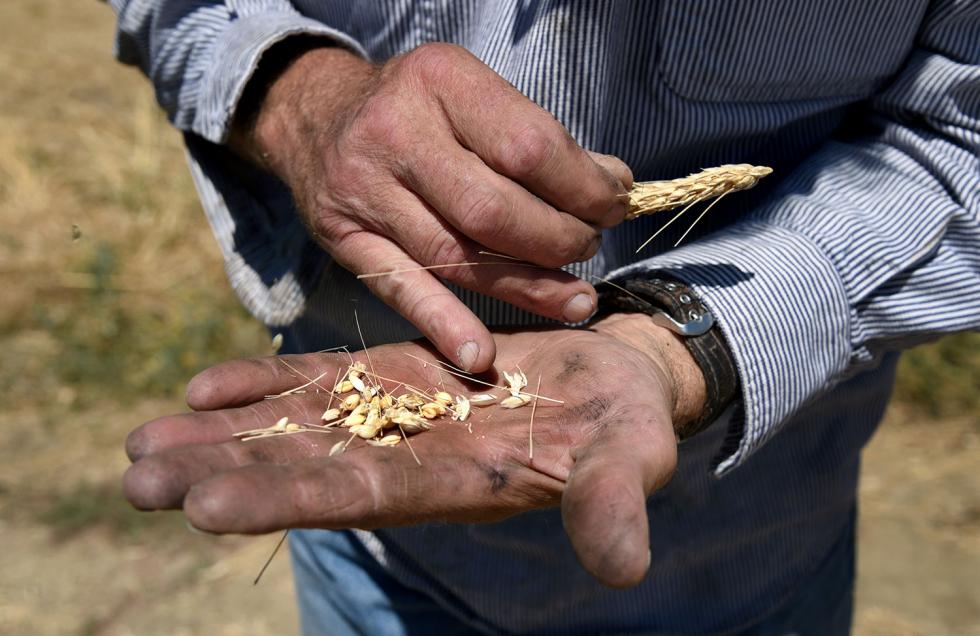
Sara Tiffany, who oversees CAFF’s Climate Smart Farming program, says occultation increases the feasibility and effectiveness of climate-smart farming practices, such as biointensive no-till, a system that attempts to get maximum yields on small plots of land in a sustainable manner.
“This method of weed control appears to be a huge labor saver in terms of weeding and bed preparation,” Tiffany says of occultation. “When combined with irrigation, the weed seeds germinate and decompose in place, adding fertility to the soil while decreasing the weed population that would have otherwise been a problem during crop productivity. Occultation is a common practice among farmers who practice biointensive no-till, because it saves labor in a farming system that is very labor intensive. I think occultation and other ‘alternative’ methods of important agricultural operations — like weeding — demonstrate the opportunities that avail themselves when people think outside the box.”
Elsewhere, CAFF is leading a biointensive no-till trial with four farms modeled after Singing Frogs Farm in Sebastopol. “They’ve been able to combine really amazing adaptation and innovation in order to produce a lot of food on a very small amount of land, while essentially building and contributing to their ecosystem services by building carbon, lowering water requirements, providing a huge amount of biodiversity with the kind of plantings they do, and the list goes on,” Tiffany says.
Another project involves eight farmers — primarily in nut tree crops — establishing demonstration sites of cover crop implementation. A cover crop like legumes is often planted after the cash crop to build soil structure, slow erosion, add nitrogen, increase the soil’s water-holding capacity, suppress weeds and control pests. The fourth project (in partnership with UC Davis) integrates livestock into vineyards. CAFF provides training, technical assistance and soil sampling, and will use the data from the trials to create a guide for other farmers.
“From the outside perspective, it can seem to the public like it’s probably just easy: ‘Why don’t you just cover crop? Why wouldn’t you?’” Buerer says. “But really the reality of it is there are a lot of adjustments that need to be made, and some risk involved, so if there’s some support in terms of technical assistance or funding to make that transition easier, then that’s really important.”
Farmers come to climate-smart practices from different entry points, and CAFF says it’s trying to meet them where they are. The organization serves a spectrum, not just the Whamonds or the Kaisels of the world, but also those who won’t ever utter the words “human-caused climate change.”
“I’ve (heard) folks talk about, ‘Well, the reason I started growing cover crops is because I was getting huge cracks in my soil’ — which is in part because of the soil around here — and they were losing almonds in those cracks,” Tiffany says. “It was getting to be like tonnage they were losing. So they planted something in there to try and knit the ground back together a little bit, and it helped a lot, and then they saw all these other things happen.”
Tiffany points to an interesting example after California’s drought between 2011 and 2015 — the driest period since record keeping began in 1895 — which led growers to leave 500,000 acres idle as surface water allocations were curtailed. Not long after came an intense winter with heavy rains and flooding. Tiffany would drive around Sacramento Valley and see two orchards side by side, one with a cover crop and one without. “The one that does not have a cover crop is sitting under inches of water, probably for weeks, the road is flooded, the drainage ditch is full and flowing,” she says. But the farm with a cover crop allowed for the water to infiltrate the soil. “We have a saying in our cover crops project: We want to help people keep water where it falls.”
As seasons go, this summer has been good for Hillview Farms. There were fewer really hot days than the year before and not nearly as much smoke from wildfires, Michael Whamond says. On this August day, it’s barely 11 a.m. and already 80 degrees, and the heat is starting to wear on Buerer and Feiereisel, who’ve been harvesting carrots for a couple hours. It’s projected to be another triple-digit day. Feiereisel scoops up a handful of soil with a few earthworms wriggling around, evidence that the Whamonds’ approach to soil management is working. This soil is alive.
Tackling the Problem With Science
The climate-smart methods of cover crops, composting and reduced tillage aren’t new-fangled ideas. “These are practices that have been around for thousands of years. We’ve been doing research on them for hundreds of years. No one’s inventing new stuff,” Tiffany says. “But because of advances in agricultural sciences, where the farmer can say, ‘Oh, this is good for the soil, oh, this is good for the yield,’ we’re able to bring the lens of climate science to it. These things decreasing carbon are going to have an impact on climate mitigation.”
The timing couldn’t be more critical. In August, the United Nations’ Intergovernmental Panel on Climate Change released a report citing land use as responsible for 23 percent of all greenhouse-gas emissions caused by humans. Agriculture takes much of the blame. Deforestation to produce soybean fields for animal feed, oil palm plantations and cattle pastures; methane emissions from cattle and sheep, rice fields and biomass burning; and nitrous oxide from fertilizers and manure in croplands are the major culprits.
In California, only 8 percent of emissions come from agriculture, but this sector can become a bigger part of the solution by acting as a carbon sink. Cover crops and composting remove carbon from the air and absorb it in millions of acres of soil — known as carbon sequestration. Reduced tillage prevents carbon from getting into the atmosphere in the first place. While the science continues to evolve, researchers at UC Davis recently published the findings of a 19-year study that identified compost as key to storing carbon in the semiarid cropland soils they investigated, whereas cover crops weren’t as effective. “We’d make more progress by incentivizing compost,” co-first author Nicole E. Tautges, a cropping systems scientist with the UC Davis Agricultural Sustainability Institute, said in a news release.
In terms of climate-change adaptation, UC Davis is already a key player as a leader in plant science and agricultural research. Its scientists, in partnership with industry, have long been working on plant breeding to develop high-yielding, drought-tolerant, disease-resistant and fast-maturing plant varieties. The university is surrounded by seed companies, including some of the largest in the world.
As academics do their part, other efforts in the Capital Region are aimed at training a new generation of farmers how to care for their land with climate resilience in mind. In mid-August, the 11 students in this year’s California Farm Academy, part of the Center for Land-Based Learning, start class with their weekly field walk, talking about what they see along the way — a practice to develop their observational skills, says farm program manager Maureen Thompson, who has been with CFA since its inception in 2012.
“The leaves are starting to look a little tired. They’re in their last days,” says student Karen Vikstrom. The students notice a ton of tomatoes. “This is the best year of nutrient management I think we’ve had, which is really cool,” Thompson says, reminding the students that adding nutrients to the soil — such as planting cowpeas as a summer cover crop — helps with carbon sequestration and produces better fruits and vegetables. “Our nutrient management this year is excellent, and the fruit is showing that.”
Vikstrom and her husband bought 5 acres to farm in Mt. Shasta when she retires as a genetic counselor. “Some of those words I’d never heard about until the last year, like permaculture, biodiversity planting, hedgerows, cover crops,” she says. “Really I learned about that by doing this academy.” Thompson says CFA helps students become “resilient, responsible farmers,” ready for an unpredictable future.
Karen Vikstrom picks zucchini at the educational plot of the
California Farm Academy in Winters.
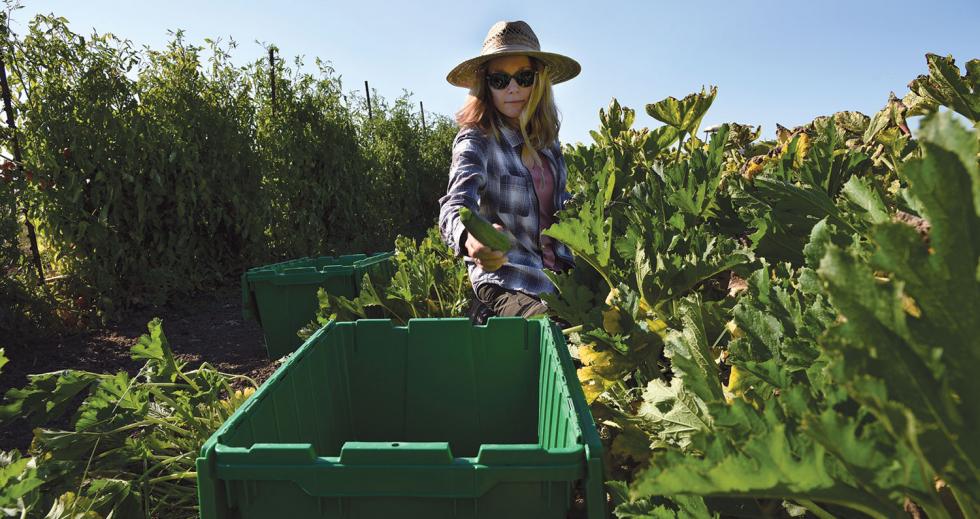
Not long after the United Nations’ IPCC report came out, Paul Underhill of Terra Firma Farm, a 200-acre certified organic farm in Winters, referenced the report and related media coverage in his email newsletter to customers. The discussion, he wrote, needs to move to adaptive strategies. Talking about solutions like getting people in wealthy countries to eat less meat are improbable, he wrote.
“(Policymakers) need to shift the focus to adaptation: making huge new investments to help farmers figure out how to adjust to the changing climate,” Underhill wrote in this newsletter. “New crop varieties, funding for development of irrigation infrastructure, loans for farmers to invest in crops they have never grown before in their area. … Worldwide, governments will also have to quickly develop and implement free or very low-cost insurance against total crop loss if they want people to continue working in agriculture. Small and medium-sized farmers — yours truly included — are not financially capable of withstanding disasters. And existing government-backed crop insurance programs primarily target large growers.”
Later, in an email to me, Underhill wrote, “Most farmers simply are not financially capable of adapting to or surviving the challenges posed by climate change. It’s not just important for farmers. It’s also important for the rest of humanity who generally expect to be able to eat three meals a day.”
Coming Together
In late September, I drive back to Hillview Farms. The pace of work has slowed, but it’s been a crazy morning for Michael Whamond, who has just returned from Nevada City, where he’d gone to buy supplies. The National Weather Service had issued a red flag warning for much of Northern California, with high winds expected to increase fire danger, prompting PG&E to announce it might shut off power to as many as 67,000 customers across six counties, including Nevada County. As a result, businesses in Nevada City had closed, and Michael Whamond returned empty-handed.
(In October, PG&E cut power to nearly 740,000 customers in Northern California over the course of several days, causing life to grind to a halt in many places. During the first blackout, in Capay Valley, Kaisel says he was “dead in the water without power,” unable to mill flour for the upcoming weekend’s farmers markets in San Francisco and Oakland.)
Shanon and Michael Whamond have run their business, Hillview
Farms, for the past eight years. The past three seasons, they’ve
operated their business at a 2-acre farm in rural Placer County
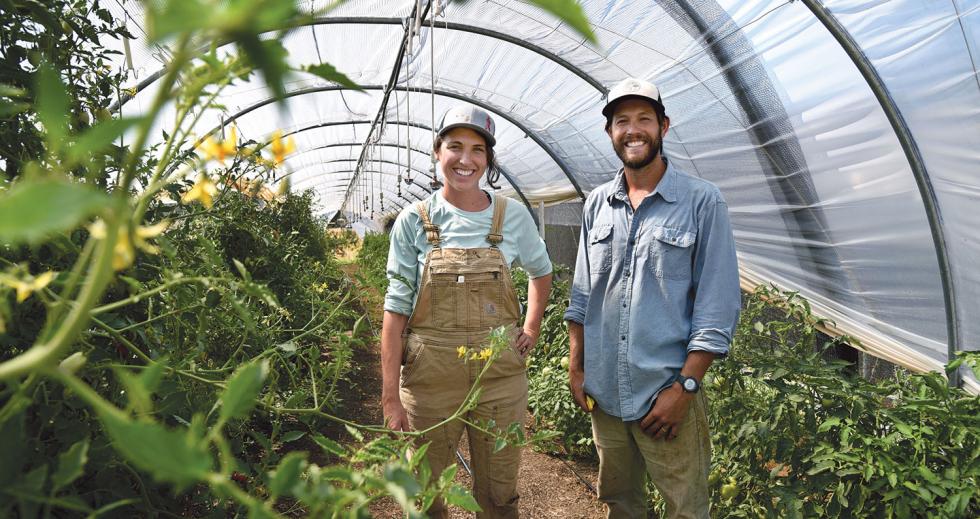
Shanon and Michael, who met at San Diego State, started farming about eight years ago, first with a small plot at Michael’s parents’ house in Auburn before moving three years ago to land previously farmed by Japanese immigrants as fruit orchards that was fallow for many years. The first thing the Whamonds did was symbolically take the tractor out of the field — they wouldn’t be plowing the land and disturbing the soil — and create a permanent bed system, which Michael says has enabled them to reduce tillage and produce “a lot of food on a very, very small scale.”
“Traditional agriculture, maybe a conventional farm can do about $9,000 an acre,” Michael Whamond says. “A pretty good vineyard maybe does $11,000. A really good organic traditional farm that does tractor, tillage or reduced tillage, they’re probably doing between $20,000 and $30,000 an acre. We’re far above. We’re anywhere from doing $100,000 to about $200,000 an acre on this small, compact scale, producing real high-quality vegetables.”
The Whamonds say Hillview proves a small-market-garden farm can be climate-smart and an economically viable business. But it’s not easy, and there’s a cost to sustainable soil management and storing carbon. Why should farmers shoulder the whole burden? To that end, the California Department of Food and Agriculture launched its Healthy Soils Program Incentives Program in 2017 to provide grants to farmers that sequester carbon, reduce greenhouse gas emissions and improve soil health. The CDFA awarded 194 projects for the 2018 program, totaling about $8.7 million in grants.
While California farmers can access support, the U.S. Department of Agriculture has largely neglected this role. An investigation by Politico published in October found that the USDA spends just 0.3 percent of its $144 billion budget helping farmers adapt to climate change. “Even these limited efforts, however, have been severely hampered by the Trump administration’s hostility to even discussing climate change, according to interviews with dozens of current and former officials, farmers and scientists,” wrote the author. The USDA, for example, ignored its own climate resilience plan earlier this year and President Donald Trump has falsely called climate change a “hoax” despite overwhelming scientific evidence to the contrary. Meanwhile, wet weather across the U.S. this spring resulted in a “record-shattering 20 million acres unable to be planted,” according to Politico.
“We’ve really got to come together, and I think that has to do with climate awareness in general,” Michael Whamond says. “What decisions do we want to make right now so in the future we can be better off? We’re just trying to do it as our little farm business. We still do some tillage and things like that, but we’re constantly observing and trying to become better at our craft to be more resilient to these changes.”
Kali Feiereisel and Emily Buerer, of Community Alliance with
Family Farmers, harvest carrots at Hillview Farms as part of a
pilot project in CAFF’s Climate Smart Farming program.
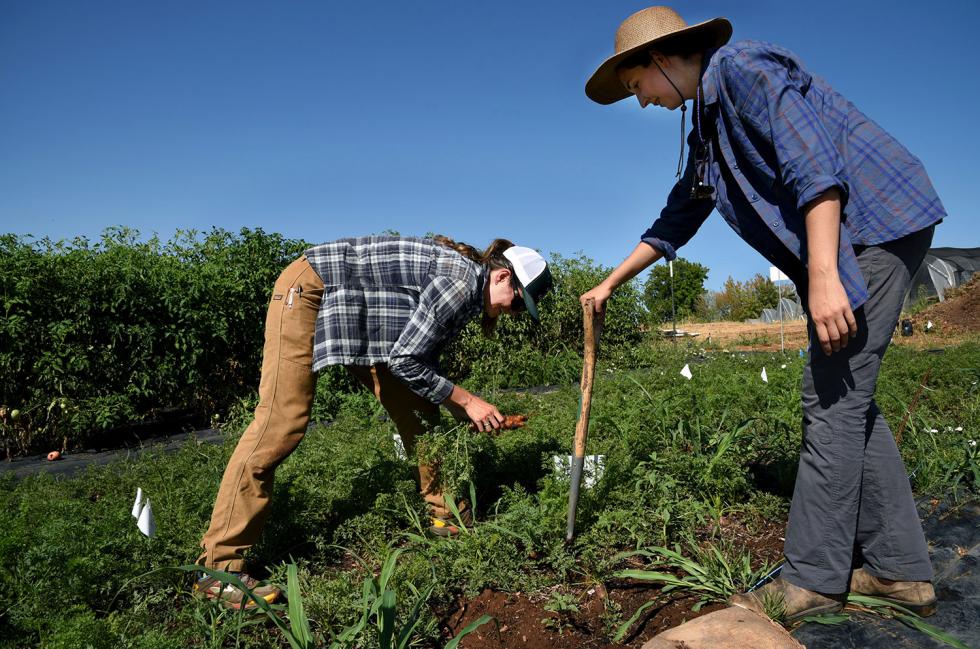
This sentiment echoes what Underhill of Terra Firma Farm points out: Farmers need incentives and infrastructure to make changes that could help them mitigate or adapt to climate change. This could come in the form of the consumer dollar rewarding growers who use climate-smart practices and from governmental policies and subsidies that pave the way for their implementation and help reduce the risk.
“I get overwhelmed at the end of the day because sometimes I feel like I’m not doing enough,” says Shanon Whamond, sitting on a couch on a small covered patio at the Hillview property, for a brief reprieve from the endless tasks of the day until it’s time to rise to her feet again for many more hours of work in the late-summer heat.
“We do care about climate change,” she says, “but we’re just trying to keep Johnsongrass from overtaking our farm. It’s overwhelming, and sometimes it’s a little disheartening because we do work so hard, sometimes we feel a little beat up at the end of the day. But I think the fact that we are continuing to farm, that is all we can do in this moment is just keep going, that is our activism. We’re trying our hardest and making mistakes, and we’re bouncing back and we’re continuing to farm.”
Recommended For You

The Transportation Revolution
How we get around is rapidly evolving, and more change is coming
Several public and private sector partnerships are helping to position the Capital Region as a leader in the new mobility revolution.
Part of this month’s Innovation issue
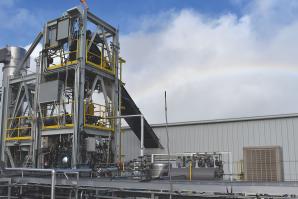
Recycling: Turning Trash Into Energy
FastOx gasification could be the solution to our recycling crisis
Every year, the United States generates around 260 million tons of trash. And no one knows what to do with it. No one, that is, except serial entrepreneur Mike Hart, the CEO of Davis-based Sierra Energy.
Part of this month’s Innovation issue



